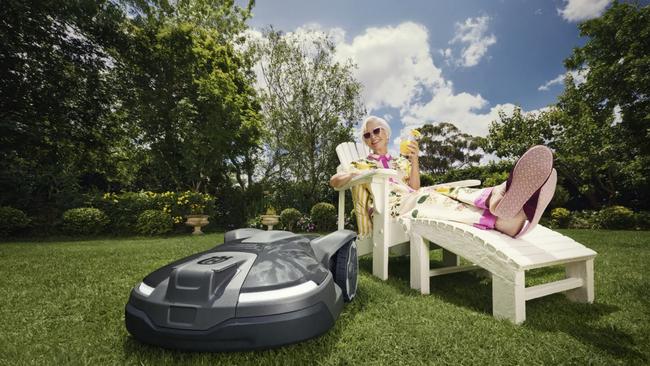Battery power on the rise but will not replace petrol engines – yet, says Husqvarna boss
Unlike fellow Swedish-headquartered company Volvo, Husqvarna isn’t set to shut down its production of petrol engines despite soaring growth in battery-powered equipment. Here’s why.

Business
Don't miss out on the headlines from Business. Followed categories will be added to My News.
Outdoor power equipment is facing its automotive industry moment, according to Husqvarna chief executive Pavel Hajman.
Lawn mowers, brush cutters and hedge trimmers are increasingly becoming battery powered, with the smell of oil and petrol slowly wafting away from Australian sheds and home workshops.
About 40 per cent of Husqvarna’s products are electric – a ratio that is expected to rise to about 60 per cent by 2026. “There has been double-digit growth in battery products for a number of years, and will continue for a number of years,” Mr Hajman tells The Australian from Stockholm.
“And we’re now developing a wheeled battery assortment – so bigger products like tractors. The whole transition to electric products is something that is very similar to what’s happening in the automotive industry.”
But like any transition, there are challenges as customers adjust and manufacturers move at different speeds.
Volvo – the headquarters of which are about a two-hour drive west of Husqvarna’s – has put a firm date on the end of internal combustion engines, declaring its cars will be fully electric by 2030. Ford, Mercedes-Benz, General Motors and others have also agreed to phase out petrol and diesel engine sales by 2040 and earlier in key markets.
While Mr Hajam has drawn parallels between the automotive and outdoor power equipment industries, he is taking a more balanced approach to Volvo and the other carmakers.
He says battery-powered products are impractical in some uses, despite their popularity.
“We are going to launch a product that is a 50cc equivalent battery product, with quite a large battery.
“But it doesn’t really support, for example, a logger in the forest that is out for a full day because it’s also related to ‘how can you charge your stuff when you’re out in the forest or if you’re out in the field’.
“Of course, you can put a lot of power into a battery, but the battery becomes so big that you can’t lift the chainsaw or anything like that. That’s not viable yet.”
For this reason, he sees petrol powered outdoor equipment being available for the foreseeable future.
“For engines above 50cc, maybe about 60cc, I still think that for years to go they will actually remain petrol driven.
“We are developing those engines to become better and better from an emissions perspective because we still want those to be as environmentally friendly as possible. And we are putting a lot of investments into the next generation, and the next generation of petrol engines. Likewise, we are also developing and looking into alternative fuels.”

Ineos Automotive CEO Lynn Calder has adopted a similar approach. Ms Calder said too many governments have placed all efforts on decarbonising roads on electric vehicles, when instead a mix of powertrains is needed to ensure emission reduction targets are met, not to mention making petrol and diesel engines greener.
Another problem is the bigger the battery, the more expensive it is – although Mr Hajman is confident that problem will be solved in coming years.
“Prices on batteries are going down and the surface energy density in batteries is going, so eventually over a number of years there will be solutions for that.”
A third barrier to more widespread battery adoption is customers, particularly in Australia, being slow to embrace robotic power equipment, despite the success of robotic vacuum cleaners and indoor connected devices.
It’s a hesitancy shared with the automotive industry, in which the idea of electric vehicles may sound appealing but the lack of charging infrastructure creates anxiety.
For Mr Hajman it is a matter of seeing is believing and as more Australians see robotic lawn mowers and other equipment in action, the more they will become comfortable with technology.
Already, Husqvarna has a host of commercial customers in Australia using its robotic lawn mower – which it first launched in 1995. Models are being used at Taronga Zoo, Canberra Institute of Technology and even the Big Banana. Mr Hajman said overseas installations include Microsoft’s sprawling headquarters at Redmond, Seattle, as well as top football fields and golf courses.
“We are a market leader in robotics. We have been building the industry for 30 years now, and we have several million of these robots out on lawns, predominantly in Europe. We have more than half of the market in Europe – and have had for many years.
“But it took us 20 years in Europe to grow the market, and it’s only been in the last 10 years that we’ve been reaping the benefits. That’s why it’s important for us to make sure that we get some professional installations in Australia because those will be visible to a lot of people and people will be curious, and they will ask about the machines.”
As for curiosity, Husqvarna has attracted a key advocate in former British prime minister Boris Johnson, who has even posted videos of his robotic lawn mower.
“The way the automotive industry is being changed through electrification is the same way that our industry is being changed, and it takes time to change the mindset and the perception of people to understand that there are alternatives to this.”
More Coverage
Originally published as Battery power on the rise but will not replace petrol engines – yet, says Husqvarna boss





